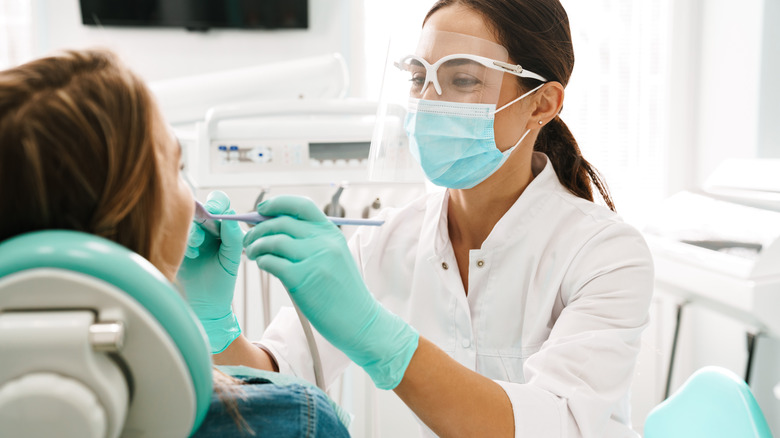What Causes A Bump On The Roof Of Your Mouth?
The roof of your mouth, known as the palate, consists of two parts: the hard and soft palates. According to Medical News Today, the hard palate sits at the front and is made up of bone that gives the mouth structure. On the other hand, the soft palate extends from the hard palate at the front of the mouth to the uvula at the back of the throat and is made up of muscle. This palate plays an important role in holding the teeth and gums together and helps with swallowing and speaking.
Another function of the soft palate is to separate the oral and nasal cavities, allowing us to breathe and eat. This action is controlled by the uvula, a small fleshy projection at the back of the throat, which is also part of the soft palate. The uvula helps block nasal cavities, preventing food or liquids from entering our noses. The soft palate also plays a role in speech. It helps produce certain sounds by controlling the air flow through the oral and nasal cavities.
Generally speaking, the roof of the mouth is a sensitive area that can be affected by various conditions, including bumps. Bumps on the roof of your mouth can be a common occurrence, and can have various causes. Though most mouth bumps are pretty harmless and will resolve on their own, others can indicate a more serious condition. Let's dig in.
Many bumps on the roof of the mouth aren't cause for concern
One of the most common causes of bumps on the roof of the mouth is canker sores, according to Healthline. These small, painful, red bumps can appear on the roof of the mouth, among other areas. They can be caused by stress, injury, or certain foods, says the Mayo Clinic. While canker sores are usually not serious, they can be uncomfortable and may take a week or two to heal.
Bumps on the roof of the mouth may also be mucoceles. Mucoceles are fluid-filled sacs that form on the roof of the mouth due to damage to the salivary glands. They are often painless but can be uncomfortable — they usually go away on their own within a few days or weeks. If they are large or causing discomfort, they can be removed by a surgeon, says the Cleveland Clinic.
Torus palatinus is a bony growth that develops on the roof of the mouth. It is a harmless, noncancerous growth that can occur in about 20% of the population, explains the Cleveland Clinic. Torus palatinus is usually painless and does not require treatment unless it is causing discomfort.
In some cases, bumps on the roof of the mouth may be caused by a cold sore. According to the Mayo Clinic, these small, painful, fluid-filled blisters are also known as fever blisters. They can also occur on or around the lips and inside the mouth. They are caused by the herpes simplex virus (HSV), which can be transmitted through close personal contact, such as kissing or sharing utensils.
When to see a doctor
If you notice a bump on the roof of your mouth, it is important to monitor it. If it persists or is accompanied by other symptoms, it's always best to consult your doctor. Persistent bumps on the roof of the mouth may indicate a more serious condition that requires prompt treatment — this is especially true if the bump does not go away after a few days or weeks. Your doctor might need to take a biopsy of the bump to determine the cause of the growth.
If the bump on the roof of your mouth appears white, this may be a sign of a fungal infection, says Medical News Today. Your doctor may prescribe antifungal or other medications to treat the infection and prevent complications. Bumps on the roof of the mouth can be caused by more serious conditions such as oral cancer, which can be caused by a range of factors, including tobacco use, heavy alcohol consumption, exposure to the human papillomavirus (HPV), and prolonged sun exposure on the lips, says the Mayo Clinic.
The bumps associated with oral cancer do not go away and can be accompanied by other symptoms such as difficulty swallowing or speaking, persistent mouth sores, unexplained bleeding in the mouth, a lump or thickening in the cheek, a persistent sore throat, and changes in voice. Treatment for oral cancer depends on the type and stage of cancer and may include surgery, radiation therapy, chemotherapy, or a combination of treatments. Early detection and treatment of oral cancer can improve the chances of a successful outcome.



